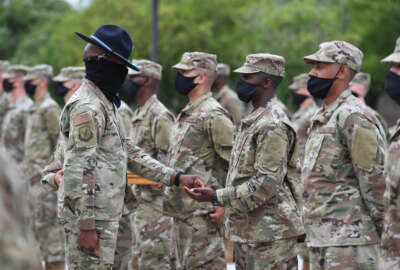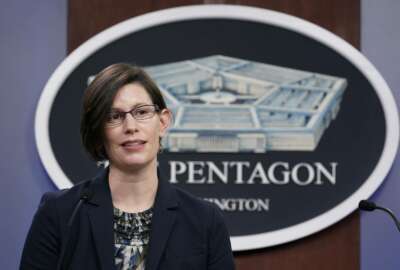Army plans major changes to recruiting after falling short of 2023 goals
The Army ended finished 2023 with 55,000 new recruits, significantly short of the 65,000 it had aimed for in the fiscal year that ended on Saturday. To help close...
Big changes are coming to the Army’s recruiting apparatus after several consecutive years of recruiting shortfalls, including an elevation of the stature of the service’s recruiting command, a new career field for military recruiters, and new goals that target a wider demographic of young people.
The Army finished 2023 with 55,000 new recruits, significantly short of the 65,000 it had aimed for in the fiscal year that ended on Saturday. And not all of them are in uniform quite yet: About 4,600 went into the service’s delayed entry pool, held in reserve for what’s expected to be another tough recruiting year in 2024.
Christine Wormuth, the secretary of the Army, said officials always knew the 65,000 target was a “stretch goal,” and it’s not yet clear how many new accessions the Army will be able to achieve this year.
“The recruiting enterprise in the Army very much understands how important that role is — they don’t need us to signal to them to put the pedal to the metal,” she told reporters at the Pentagon Tuesday. “We’ve got a lot of work to do to implement all of these changes, so I would imagine we’ll settle on something lower than 65,000 for 2024.”
That’s partly because some of the changes the Army is making will take years to put into place.
For example, officials want to make a significant change in the types of Americans recruiters spend their time targeting. By 2028, they want at least a third of all new recruits to have at least some postsecondary education.
“Since this is an existential issue for us is, we’ve really tried to focus on changes we can start to make right now,” she said. “And a huge change in the last 20 years is that many more young people go to college after high school than they used to, so the high school market is actually shrinking. The Army actually gets 50% of our contracts from high school seniors or high school graduates. But when you look at the broader labor market, only 15 to 20% of the labor market is comprised of individuals with just high school education.”
Meanwhile, there will also be some significant changes to the recruiting workforce. Wormuth said the Army plans to create a new “talent acquisition” enlisted occupational specialty dedicated to recruiting. The new designator will be 42-T. The service will also stand up a new corps of warrant officers who specialize in recruiting.
In both cases, the new career fields will come with additional training, a more rigorous selection process, and new aptitude testing to determine which soldiers are most likely to succeed at convincing prospects to join the service.
“We are going to shift from sort of a borrowed workforce to a permanent, specialized, recruiter workforce,” she said. “We do have some specialized recruiters, but many of our recruiters come from different specialties all across the Army — they do a stint in recruiting, and then they go back out to do the thing that is their main military occupational specialty. Unlike the private sector, we do not have a specialized permanent recruiting workforce, and we need to change that.”
And considering that recruiting issues are “existential” to the Army, officials have concluded they need to raise the stature of Army Recruiting Command within the service’s organizational chart. Going forward, the command will be led by a three-star general instead of a two-star.
The relatively-new Chicago-based Army Enterprise Marketing Office will be folded into that command, as will the Army’s Cadet Command, which is in charge of recruiting and training officers. And future commanders of Army Recruiting Command will serve unusually long tours of duty in that position: four years.
Gen. Randy George, the Army’s chief of staff, said the service also wants Recruiting Command to become a center of experimentation that helps refine the Army’s approaches to recruiting. Much of that will be led by a new deputy commanding general who will focus on innovation.
“In my experience, the best ideas usually come from the bottom up,” he said. “So what we’re going to do is make sure that we get the resources and authorities down to USAREC — not anywhere here in the building, but out to USAREC. We want to make sure that they have the software they need. If there’s contracting that needs to happen, or really pushing through some of the other bureaucratic hurdles that might be resident on occasion, we want to have somebody to do that.”
George said the Army also needs to do a much better job of studying and evaluating what works and what doesn’t when it comes to recruiting strategies, since those strategies will need to evolve over time.
So the service also plans to create a new evidence-based organization at the Pentagon to pore through data about what kind of bang for the buck it’s been getting out of different enticements for prospective recruits.
“We’ve given bonuses, we’ve given station of choice, we do a lot of these things, but what we haven’t done well enough is understanding how these things are working,” he said. “These are things we should have been doing but we haven’t been doing. We have [operations research and systems analysis] capabilities to do that, including at West Point, but we need to piece all that together. If we need to hire additional folks, we’ll do that as well.”
Copyright © 2025 Federal News Network. All rights reserved. This website is not intended for users located within the European Economic Area.
Jared Serbu is deputy editor of Federal News Network and reports on the Defense Department’s contracting, legislative, workforce and IT issues.
Follow @jserbuWFED






